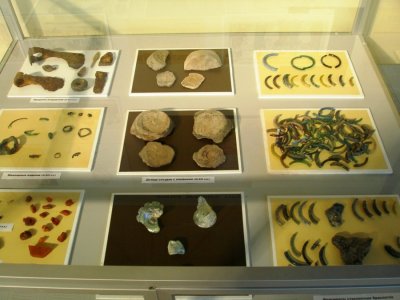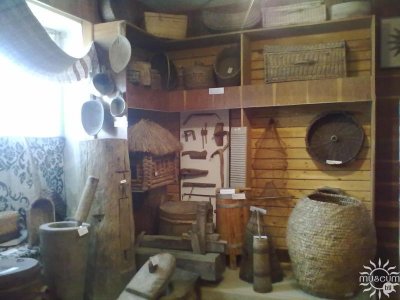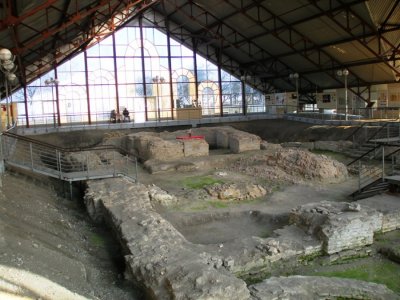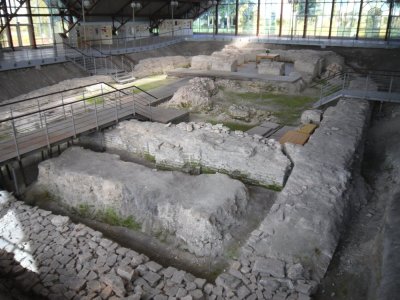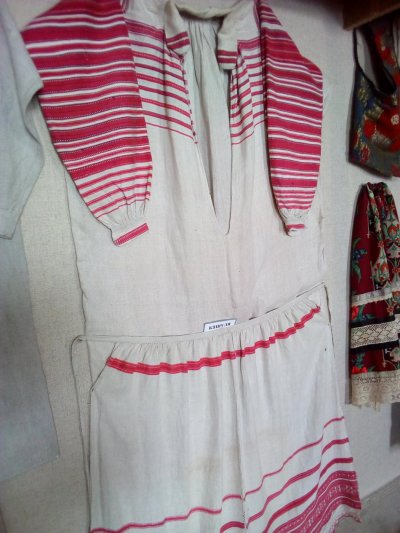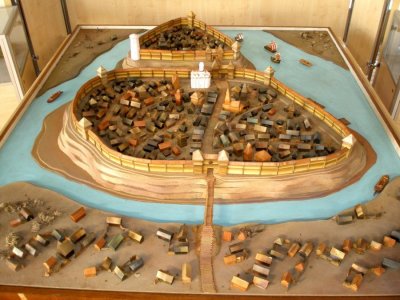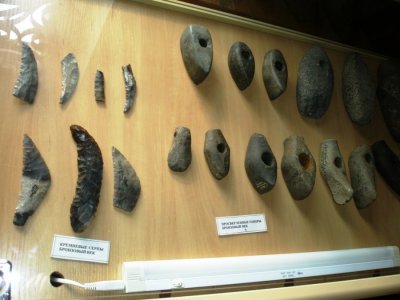The Turov Museum of Local Lore is one of the oldest museums in the Gomel region. It was founded in 1927 on the basis of the school history and nature club, and had more than a hundred exhibits. The founder and the first director of the museum is Maxim Yemelyanovich Bruy, a geography teacher. The librarian of the People's House, Parfen Antonovich Shchekotovich, took an active part in the creation of the museum, whose whole life was subsequently connected with the Turov Museum. The museum's collection, collected before the war, included two thousand objects of archeology, ethnography and everyday life, handwritten and printed publications. Currently, the museum has 6 exhibition halls: "The archaeological past of Turov", "Crafts and crafts of the Turov region", "Peasant hut", "Nature of the district", "The Great Patriotic War in the district", "Retro style". From 1989 until 2016, the exposition was not dismantled. In 2016, an exhibition hall "In retro style" was equipped, which houses objects depicting the era of the USSR. In 2017, a new exhibition hall "Peasant Hut" was created, which houses objects that existed in peasant huts at the end of the 19th century. 20th century. Currently, the main fund of the museum consists of more than 12 thousand objects on various subjects. At the same time, the scientific and auxiliary fund consists of more than 9 thousand items.
The exposition "Archaeological past of Turov" contains two rare and unique objects not only for Turov, but also for the entire territory of Belarus. The first item is a celt, a type of bronze axe with a vertical sleeve, into which the handle was then inserted. Hence its second name — the woolly axe. There were one or two special lugs on the blade for better fastening of the handle: it was tied with a rope. What the Celt would look like depended on the hilt. If a straight handle was inserted into it, it looked like a chisel. If a handle bent at an angle was inserted into it, it took the form of a hoe or an axe. Axes similar in ornamentation, shape, and size were found in large numbers in the Danube River basin, in the western regions of Ukraine, and on the territory of Poland. Such an axe was used as a weapon in the Bronze Age. It was owned by men who held a high social position in society. It belongs to the late period of the Bronze Age and can be dated between 1200 – 900 BC.
The second item is an adobe oven of the end of the III-beginning. The furnace was discovered during archaeological research of an early Iron Age settlement located from the village of Careful. A clay hearth has been preserved from the furnace, the vault has collapsed, its traces are clearly visible in the section of the furnace. The oven was used by ancient settlers for household and, obviously, for ritual purposes, because a ritual loaf was found on the hearth. Such loaves imitated bread and were sacrificed to the gods, probably fire, because they were placed both inside the oven and outside.
The exhibition "Crafts and crafts of the Turov region" also contains one of the unique items characterizing the history of Turov. This is a women's headdress – galovachka. A long-standing headdress of married women in a David Gorodok-Turov outfit. It existed in the 18th century . 20th century . It consisted of the galovachki proper (a rigid frame - base in the form of a cap without a top, the frontal part of which turned into a trapezoidal ridge 8-15 cm high, 10-17 cm wide), a kind of cap (a calico cover or linen cloth, worn on the crest), a ryabushko (a belt made of the same materials that encircled the frame), sarpanki (a band of gauze-thin cloth 3.5 - 5 m long, 50 - 60 cm wide); made up in several layers, it wrapped around the comb, passed under the chin and draped with free ends on the back. Often the cap was complemented with a cashmere shawl with a fringed fly (made up diagonally, passed under the chin and tied at the crown). The festive galovachka was decorated with embroidery with thin red, yellow, black silk or crimson, blue, black threads of onion wool, patches of golden braid. Geometric or strongly geometrized floral ornament (rhombus, spruce, palmette) was located on the cap and rowan, where they were not covered with a sickle. The starched shirt was not decorated, except for narrow (about 0.5 cm) red ribbons at the edges of the circle and at the ends. Dark blue or black stripes were made on mourning dresses.
There is also a museum exhibition "Ancient Turov", which is located on the site of the Ancient town of Turov. The foundation of the temple, which is now open to visitors, was discovered by accident in 1961. The students were digging a utility pit and suddenly came across a section of a brick wall. At that time, an expedition from Moscow was conducting excavations at the detinets in Turov. Archaeologists immediately appreciated the possibility of identifying the remains of a monumental architecture structure and reported this to Karger, a major specialist in ancient Russian monumental architecture. In the autumn of 1963, Karger opened the remains of the temple with trenches along the perimeter of the walls, determined the time of its construction (the second half of the XII century), the safety of the remains and filled it in. The opening of the temple gained real prospects only in 2004, when the President of Belarus got acquainted with the ancient Turov settlement and proposed using the historical and archaeological resources of ancient Turov in the interests of the city's revival. In just a few months, the ancient temple was opened and a dome was erected over it. Archaeological work was carried out under the supervision of the head of the archaeology sector of the Institute of History of the Academy of Sciences of the Republic of Belarus Pyotr Fedorovich Lysenko, and the construction of the pavilion was carried out by the builders of the region.
In September 2005, on the occasion of the millennium of the Turov Diocese, the exposition pavilion "Ancient Turov" opened its doors to visitors.
The main exhibit of the museum exposition is the foundation of an ancient temple. No information about it has been preserved in written sources, therefore the history of the construction of the temple, its name, the names of the architects and the exact time of construction are hidden from us. The temple was built approximately in the second half of the 12th century in the tradition of the Kiev school of architecture, and belongs to the category of typical six-column, three-apse single-domed temples. Only the foundation and part of the walls of the Turov temple have been preserved. Most of the walls are 30-50 cm high, the apse wall has been preserved much higher – up to 2 m. The temple was built of plinth in the technique of equal-layer masonry, characteristic of the 12th century. Archaeological research has established the cause of the destruction of the temple - the earthquake of 1230.
During the excavations of the temple, burials in slate sarcophagi were discovered. Slate or "pyrophilite slate" is a beautiful noble dark pink stone that was mined in Ovruchsky quarries (now Zhytomyr region). For the Middle Ages, such burials were of status, as representatives of the elite of society were buried. On the territory of Belarus, such burials are known only in Turov. The first three sarcophagi were discovered by M. Karger in 1963. All the burials in them turned out to be disturbed, and the sarcophagus in the northwestern corner of the narthex was filled with a pile of human bones from several skeletons. The last two sarcophagi were discovered during the construction of the complex in 2005. One of the graves found near the southern wall of the temple has been preserved in very good condition. The burial of a young woman 24-27 years old, during the study, anthropologists came to the conclusion that this woman was born and grew up in Polesie, belongs to the Dregovich tribe. It was decided to reconstruct the appearance of a woman using the Gerasimov method. The very first sarcophagus was excavated in 1909 at the Boris and Gleb cemetery, on the site of an ancient monastery. The fate of this sarcophagus is unknown, only information about its autopsy has been preserved – in addition to the skeleton, the remains of decayed gold threads from the forearm to the knees were found. Most of the materials that are located in the archaeological complex "Zamkovaya Gora" and are presented for wide viewing by visitors were found during archaeological excavations on Zamkovaya Gora. However, some of the materials are being preserved at the Institute of History of the National Academy of Sciences of Belarus.
The museum's expositions
- 118 reads
